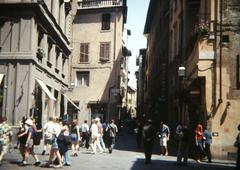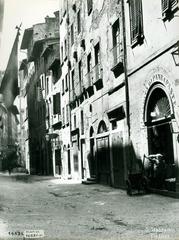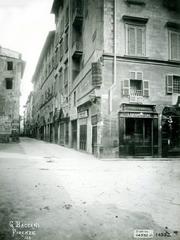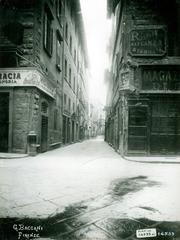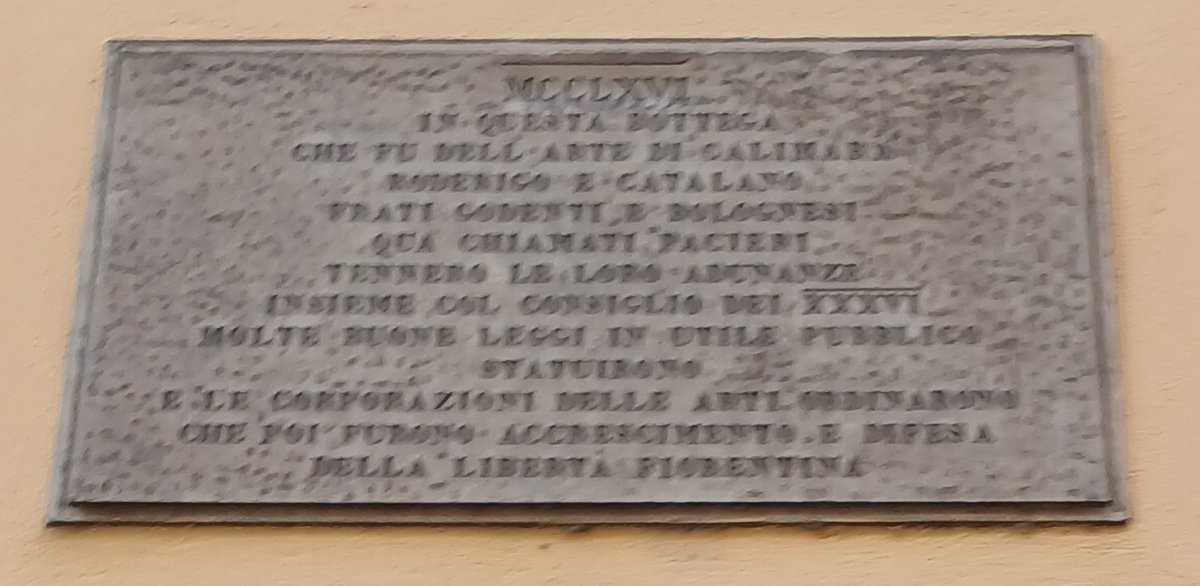
Via Porta Rossa, Florence, Italy: Visiting Hours, Tickets, and Historical Sites Guide
Date: 15/06/2025
Introduction
Via Porta Rossa is one of Florence’s most storied and atmospheric streets, serving as a living testament to the city’s medieval origins and Renaissance brilliance. Once named after the “Red Gate”—a long-vanished portal in Florence’s third circle of city walls—this street has evolved from a vital medieval thoroughfare into a vibrant showcase of local artistry, architecture, and Florentine culture. Today, Via Porta Rossa remains a must-visit destination for travelers seeking to immerse themselves in the authentic spirit of Florence, offering a blend of historic palazzi, artisan workshops, unique shops, and proximity to the city’s most treasured attractions (The Florentine).
This detailed guide provides everything you need to know about exploring Via Porta Rossa, from historical context and architectural highlights to practical visitor information, accessibility, and cultural tips.
Table of Contents
- Historical Overview: From Medieval Gate to Renaissance Street
- Architectural Landmarks and Artisan Heritage
- Cultural and Religious Traditions
- Visiting Hours, Tickets, and Accessibility
- Nearby Attractions and Walkability
- Practical Tips, Dining, and Accommodation
- Frequently Asked Questions (FAQ)
- References
Historical Overview: From Medieval Gate to Renaissance Street
Via Porta Rossa dates back to the 12th and 13th centuries, when Florence’s expanding wealth and influence prompted the construction of new defensive walls and gates. The “Red Gate” (Porta Rossa) once marked the western end of the street, near today’s Via de’ Tornabuoni, and played a critical role in regulating trade and protecting the city (The Florentine). As Florence transitioned from medieval stronghold to Renaissance powerhouse, Via Porta Rossa evolved into a prestigious address lined with stately palaces, artisan workshops, and headquarters of influential guilds.
The street’s artisan legacy is especially notable. During the Middle Ages, it bustled with workshops of linen merchants, hat makers, feather sellers, and other tradespeople. The arrival of silk weavers from Lucca in the 14th century further enriched its reputation, eventually leading to the establishment of the powerful Arte della Seta (Silk Guild), with the red gate as its emblem (Wikipedia).
Architectural Landmarks and Artisan Heritage
Palazzo Davanzati
A jewel of Via Porta Rossa, the Palazzo Davanzati exemplifies the transition from medieval towers to Renaissance palazzi. Built in the 14th century for the Davizzi family, wealthy wool merchants, it now houses the Museum of the Florentine House. Inside, visitors can explore beautifully frescoed rooms—like the famed Sala dei Pappagalli and Sala dei Pavoni—and period furnishings that evoke everyday life in Renaissance Florence. Highlights include a Madonna and Child attributed to a young Brunelleschi and an internal well in the courtyard, a mark of medieval luxury (Dolcevia).
- Visiting Hours: Tuesday to Sunday, 9:00 AM–7:00 PM
- Tickets: Around €7 for adults, with discounts for students and seniors
NH Collection Firenze Porta Rossa Hotel
At number 19, the NH Collection Firenze Porta Rossa claims to be Italy’s oldest hotel, occupying a complex that includes a 13th-century tower and interiors adorned with ancient frescoes. Over the centuries, it has hosted renowned writers such as Stendhal and Byron, and today seamlessly blends historical integrity with modern hospitality.
Artisan Shops
Via Porta Rossa maintains its connection to Florence’s artisanal past. Shops like Passamaneria Valmar (famed for decorative trimmings) and Biscottificio Antonio Mattei (renowned for Tuscan biscotti) keep traditional crafts alive. Many boutiques offer live demonstrations, allowing visitors to witness centuries-old skills firsthand.
Cultural and Religious Traditions
Via Porta Rossa is not only a commercial and residential artery but also a stage for Florence’s vibrant cultural life. The street is famously part of the route for the Scoppio del Carro (Explosion of the Cart), Florence’s spectacular Easter procession. Flag-throwers, musicians, and historical reenactors parade through Via Porta Rossa en route to the Duomo, immersing visitors in a centuries-old tradition (Easter in Florence).
Literary history also permeates the street. In the early 20th century, Palazzo Davanzati became a meeting place for avant-garde thinkers, including the founders of the influential magazine “Il Leonardo.” The NH Collection hotel, too, has played host to artists, writers, and travelers for generations (Feel the Extraordinary).
Visiting Hours, Tickets, and Accessibility
- Via Porta Rossa: Public street, accessible 24/7, no ticket required
- Palazzo Davanzati: Open Tuesday–Sunday, 9:00 AM–7:00 PM; tickets about €7; discounts available (Museums in Florence)
- NH Collection Firenze Porta Rossa: Accessible to guests and restaurant patrons; exterior architecture can be admired from the street
- Accessibility: The street is mostly flat and cobblestoned. Wheelchair users may encounter uneven surfaces, but most major sites have ramps or lifts. For detailed accessibility information, consult AboutFlorence.com.
Nearby Attractions and Walkability
Via Porta Rossa is centrally located and ideal for exploring Florence’s top sites on foot:
- Ponte Vecchio: Iconic medieval bridge, 5 minutes away
- Piazza della Signoria: Florence’s political heart, with Palazzo Vecchio and open-air sculptures
- Basilica di Santa Trinita: A Renaissance church known for its art
- Loggia del Mercato Nuovo: Covered market and the famous Porcellino fountain
- Uffizi Gallery: World-renowned art museum, a short stroll away
- Piazza della Repubblica: Bustling square with historic cafes at the street’s eastern end
Walking routes between these landmarks are flat and pedestrian-friendly, though crowds can be significant during peak tourist seasons (Florence Itinerary).
Practical Tips, Dining, and Accommodation
- Dining: Try Rooster Cafe for brunch, or Biscottificio Antonio Mattei for biscotti. Numerous trattorias and wine bars are nearby.
- Shopping: Artisan boutiques offer leather goods, jewelry, and textiles—many with live demonstrations.
- Accommodation: Options range from luxury hotels (NH Collection Firenze Porta Rossa, Dimora Palanca) to boutique stays and hostels nearby. Early booking is recommended during festivals or holidays (The Common Wanderer).
- Accessibility: Use public transport to avoid ZTL parking restrictions in the historic center. Buses with low floors serve nearby stops; the Santa Maria Novella train station is 10–15 minutes away on foot.
- Safety: The area is generally safe, but watch for pickpockets during crowded events or markets.
Frequently Asked Questions (FAQ)
Q: What are Via Porta Rossa’s visiting hours?
A: The street is open to pedestrians 24/7.
Q: Is there an entry fee to walk on Via Porta Rossa?
A: No, it is a public street. Only certain museums or attractions (like Palazzo Davanzati) require tickets.
Q: Are guided tours available?
A: Yes, numerous Florence walking tours include Via Porta Rossa and its main sites. Booking in advance is recommended (IconaToscana.it).
Q: Is the street accessible for people with disabilities?
A: While cobblestoned and sometimes narrow, Via Porta Rossa is mostly flat. Key sites have ramps or lifts, but check with individual attractions for specifics (AboutFlorence.com).
Q: How do I get to Via Porta Rossa?
A: It’s centrally located, easily reached on foot from major squares or by bus to Piazza della Repubblica.
Q: When is the best time to visit?
A: Early mornings and evenings offer fewer crowds and atmospheric light. Easter is especially festive.
References
- Gatecrashing Florence’s Historic Porte – The Florentine
- Palazzo Davanzati Museum – Museums in Florence
- NH Collection Firenze Porta Rossa – Conference Hotel Group
- Made in Italy: Florence’s Artisan Heritage – National Geographic
- Palazzo Davanzati Florence – Dolcevia
- Via Porta Rossa – Wikipedia
- Feel the Extraordinary – Stroll Through History
- Easter in Florence – Tuscany Tips
- AboutFlorence.com – Accessible Florence
- The Common Wanderer – Florence Guide
- IconaToscana.it – Visit to Palazzo Davanzati

